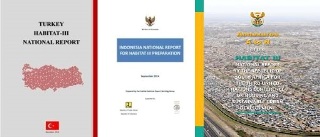What Is Happening to Habitat III National Reports?

In October 2016 Habitat III will bring together global actors in Quito, Ecuador, to build on the work of Habitat II in Istanbul (1996) and Habitat I in Vancouver (1976). The stated aim of Habitat III is to adopt a new global policy intended to guide the actions of governments, multilateral agenciesand other actors in pursuit of a more just and sustainable human habitat. HIC and the DPU are joining forces and assets to assess the national reporting process so far and to stimulate the debate around the implementation of Habitat II commitments (1996), including elements of what is currently conceived as the “right to the city,” and civil society participation.
With this objective in mind, the DPU joined the Habitat International Coalition Habitat III Working Group, which seeks a “New Habitat Agenda”—not merely an `urban’ agenda—for the 21stCentury. According to the aims of the working group, this New Habitat Agenda recognizes the ever-changing dynamics and continuity of human civilization and the built environment, respecting the urban-rural continuum, and promotes greater autonomy, meaningful participation and responsible citizenship at the local level.”
The preliminary findings of the review of national report show that few official reports are available to the public. Therefore, the study could assess eight country reports so far (Brazil, Chile, Egypt, Indonesia, Mexico, Peru and South Africa). However, that sample revealed a variety of levels in civil society engagement, with Brazil’s process showing the more-meaningful participation.
This study considered the degree of diversity in civil society representation in thenationalreporting process with regard to social identity (e.g., gender, age,ability), geography (inhabitants of different areas in the country including urban/rural, inner-city and peripheralareas,differentmunicipalities),and functional groups(representatives from different types of groups such as social movements, NGOs and academia). Since UN-Habitat—the author of the current reporting guidelines—has no discernable criteria for civil-society representation, the DPU researchers borrowed from the Food and Agriculture (FAO) model, which calls forbalanced civil-societyrepresentation: 75% of all constituents, 50% women’s participation, one-third youth, 75% of all regions concerned, and diverse types of organizations.
Although the “right to the city” was not an explicit criterion in the UN-Habitat National Reporting Guidelines, some elements of the right to the city are evident in the progress reported. For example, an annex to the South Africa report refers to the social function of land and property, and the Indonesia report cites one of the country’s land-management goals as the improvement of government control of “land speculation and large-scale land holdings, which are [a] detriment to the public interest that lead to the loss of history, identity and social functions of the city” (Indonesia National Report, p. 101). With respect to the social production of habitat, the Indonesia report also speaks of collective ownership, while the Jamaica report cites social entrepreneurship. The Mexican report speaks of “autoproduction”and the South Africa report testifies to the experience of participatory planning.
Based on the findings to date, DPU and HIC recommend improving the Habitat III processes and contents by:
1. Clearer monitoring and accountability framework for Habitat II and Habitat III:
This could be achieved by generating guidelines and criteria for evaluative reporting on the implementation of commitments made in Habitat II, as well as participatory production of the New Habitat Agenda with a monitoring strategy through which relevant actors could be held to account for past and future commitments.
2. A commitment to a coherent vision toward social justice and urban sustainability:
If Habitat III is to be a basis for transformative commitments, it is necessary to build criteria collaboratively for an explicit engagement with the vision of social justice and urban sustainability. Civil society initiatives focused on the Right to the City present an opportunity that could be built upon.
3. A comprehensive framework for implementing a vision of social justice and urban sustainability:
This calls for developing and disseminating a long-term framework for Habitat III to ensure that institutional structures are in place internationally that will enable the full exercise of the human right to habitat.
For more information on this research download the full report [pdf] and the summary of findings in English | French | Spanish | Arabic
|